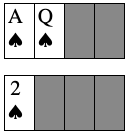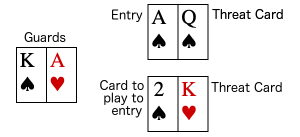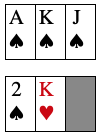ExtraTricky's Introduction to Squeezes
Preface
When I first learned Bridge, squeezes were completely mystifying to me. I couldn't understand how one was actually supposed to know when a squeeze was available, and believed that it required knowing the exact cards in the opponents' hands at the last couple tricks. Only after sitting down and really understanding how to play a squeeze recently did I understand that they are significantly simpler than I previously believed.
There are some major aspects of existing squeeze explanations (at least the ones that I've seen) that I blame for this misconception:
- They show the ending position before the squeeze card is played.
- They show all four hands, with no explanation for why the declarer would believe the position to be as shown.
- The first squeeze position they show is a positional squeeze, possibly because it has been given the name "simple squeeze".
In this introduction my goal is to explain three things from a single dummy perspective (i.e. not seeing the opponents' cards):
- How to recognize that a squeeze is possible.
- How to evaluate the success rate of a squeeze.
- How to execute a squeeze.
Finesses
Before diving into squeezes, I want to talk about finesses in order to give the reader a chance to get used to the way that I talk about lines of play in a context that they are already familiar with.
Here is one prototypical position for a finesse:

When I say "prototypical", I mean that it is an illustration of many different hands that share certain relevant properties:
- The A means that it is the highest remaining card of the suit (a winner).
- The Q means that there is one card between the A and the Q remaining (the K).
- The 2 means that the card has no chance of winning, or that declarer does not care whether the card could possibly win (a loser).
- The face down cards in both hands indicate that it does not matter if there are other cards. A finesse could be taken just as well at trick 1 or at trick 12.
- In these hand diagrams I will always put the hand on lead at the bottom unless stated otherwise.
In an actual hand, a position that falls into this prototype can arise with plenty of different cards. For example, perhaps the top hand actually has the 9 and the 6, but the only remaining spades that the opponents have are the 8 and the 5.
To execute this finesse, lead the 2 of spades. If left hand opponent (LHO) plays the king, cover with the ace. Otherwise, play the queen.
The goal of the finesse here is to get two tricks. The finesse succeeds (or wins) whenever LHO has the king of spades. In absence of other information, that will be 50% of the time. However, the finesse exists regardless of whether it will succeed or not.
I find this distinction very important. Bridge players learn quickly that a declarer knows that a finesse exists, but often without any idea as to whether the finesse will succeed. Squeezes operate in the same way.
The Automatic Squeeze
In my opinion the automatic squeeze is the best place to start. So much that I sometimes call it a "simple squeeze", but "automatic squeeze" is the usual name, so I use it here so you can look it up in other resources, and "simple squeeze" is already taken by a different type of squeeze (which I consider less simple). Unlike finesses, squeezes generally can only happen at the end of a hand. Here is a prototypical automatic squeeze ending.

Notice that there are no face-down cards this time. This is a "two card ending", meaning that it only works when these are the last two cards in each hand.
To execute this squeeze, if the heart king is high (because the heart ace was discarded), cash the heart king and then the spade ace. Otherwise, play the spade 2 to the ace and then lead the queen of spades.
The squeeze will win whenever the same defender was dealt the spade king and heart ace at the start of the hand. Do you see why?
Imagine you're a defender with both the spade king and the heart ace. When the declarer is playing cards to get to a two card ending, you essentially get to pick two cards to keep.
If you decide to throw away the ace of hearts, then the declarer will win both of the last two tricks because the king of hearts will be good.
Your only other real option is to keep the ace of hearts and the king of spades, and since this is a two card ending you can't keep any other cards. When the declarer cashes the ace of spades, your king of spades will fall under the ace, and the queen will now win.
Sometimes, the squeeze won't win because one defender has the heart ace while the other has the spade king, and can keep a second spade alongside their king. That's ok, just like how sometimes a finesse doesn't win because the king is offside.
When talking about squeeze positions, particular cards get named based on the role they play.
- The threat cards are the cards that aren't winners, but might become winners in one of the lines of play. Here they are the spade queen and the heart king.
- The entry is the card (or cards) that allow the declarer to move the lead to the other hand. In this case, it is the spade ace, and the spade 2 is required in order to make use of the entry.
- The guards are the cards that the defense holds that might prevent the threat cards from becoming a winner. Here they are the spade king and the heart ace. We also think of the guards as associated with the threat card that they are covering. So the spade king is "the spade guard", and the heart ace is "the heart guard".

The concept of a "squeeze card" is irrelevant for the technique in the way I have described it. If you are looking at other resources about squeezes, the squeeze card is whichever winner you cashed last before getting to the two card ending.
Chance of success
The condition for the automatic squeeze that I showed above to work is that the same defender started with the spade king and the heart ace. How often does that happen? It certainly is not quite as easy to think about compared to a single honor card being onside, where there is a clear symmetry.
The answer is that this squeeze works 48% of the time. Imagine shuffling just the opponents' cards and dealing them randomly between the two of them. Take a notice of where the spade king is. Of the other cards, 12 of them go to the same hand, and 13 go to the opposite hand. So the chance that the heart ace is one of the 12 is 12/25, or 48%.
The exact number doesn't matter too much, but it is good to remember that the chance that two particular cards are in the same hand is a little bit less than 50%. Each additional card that needs to be in the same hand will cut the probability to a bit less than half of the previous. So three cards being in the same hand is a bit less than 25%, four cards a bit less than one in eight, and so on.
Why play for a squeeze?
An astute reader might notice that you could get 2 tricks at the end 50% of the time by finessing the spade king instead of the proposed squeeze. 50% is higher than 48%, so you might wonder why not take the finesse instead of a squeeze.
The answer lies in what happens in the failure case. Imagine that you play down to this two card ending planning to take the finesse, and RHO holds onto the heart ace and the spade king. You take the finesse and RHO wins both of the last two tricks!
In contrast, the squeeze line always starts with cashing the second to last trick. So no matter whether the squeeze is winning or losing, or which cards the opponents hold, you get at least the same number of tricks as you would have had you just cashed out with no regard for a squeeze ending.
Because of the fact that they limit the downside, squeezes can be valuable when playing for an overtrick and finessing could risk the contract. On the other hand, if you're trying to get the last trick needed to make a big contract, it may be better to take the finesse which can be more likely but with the downside that you may go down more tricks when it fails.
Additionally, there are some times that a squeeze can succeed where a finesse can't. Let's modify the basic squeeze from before just a little bit.

Even if both the queen and king of spades are in LHO's hand, if you attempt to finesse them by leading the spade 2, they can "split honors" by playing one of them, and the spade J still can't win a trick.
However, imagine if the spade K, spade Q, and heart A were all in the same defender's hand. Then that defender still has to go down to two cards, meaning they can keep (for example) the spade KQ and set up your heart king, or otherwise they can keep spade K, heart A, and cashing the spade A sets up the J by dropping the remaining spade honor.
Since this squeeze now requires three particular cards to be in the same defender's hand, the chance of success is slightly below 25%. You can calculate that the precise chance is 22%*, but again the exact chance of success isn't so important, as much as understanding the ballpark. It's a big upgrade from 0%!
* Actually the chance is a bit higher than 22%, because one defender could have a singleton spade honor while the other has the other spade honor and the heart ace.
The quality of threat cards
Considering that we changed a queen to a jack and the squeeze still had a chance, what if we change the heart king to the queen as well?

Yup! The squeeze still exists, but in order to win it needs the spade KQ and the heart AK to all start in the same hand. So the chance is going to be a bit below one in eight.
"Wow," you might say, "These squeezes are starting to feel like real long shots." And I will agree with that. The way I think of the diminishing probability that these squeezes work is by thinking of each threat card having a quality value, where a higher quality means that it is less likely to be guarded.
- In the original example, the spade Q only has one guard: the spade K. Because only one defender can have the spade K, this is as good as a threat can get.
- Similarly, the heart K only has one guard: the heart A. So the heart K is also a perfect threat card. With two perfect threat cards, the squeeze succeeds a bit under 50% of the time.
- In the first modification, the spade J has two guards: the spade K and the spade Q. In order for the squeeze to succeed, the same defender needs to have both of the cards along with the heart A. That only happens a bit under 25% (22% if you want to be more precise) of the time.
- In the second modification, the heart queen also has two guards: the heart K and the heart A. With both modifications in place, each threat card only works on a defender (roughly) 50% of the time, and then there's another (rough) factor of 50% for them to work on the same defender, leading to the (roughly) 1 in 8 chance of success.
When you scan your initial hand and the dummy for possible squeeze endings, keeping your focus on the highest quality threat cards will tend to lead you to the squeezes with the best chance of success.
Threat cards from long suits
So far the examples have been focused on threat cards that are honors that are almost high, but not quite. There is one other form of threat cards that is important to keep an eye out for, which is a low card from a long suit in one of the two hands.
As an example, suppose that the dummy has the spade suit AKQ4, and declarer has the 2 and the 3.
At first glance, the 4 might look like a terrible threat card: there are seven cards higher than the 4 that could guard it! However, when the seven remaining spades are distributed between the two opponents, only one of them can have four or more of them (pigeonhole principle!). So since a squeeze line will involve cashing the top three spades before trying to cash the 4, only one defender can guard it, which makes the 4 a perfect threat card!
If declarer only had a singleton spade, so the defense had eight spades between them, then sometimes the spades split 4-4 and both defenders could guard the suit. However, whenever they split 5-3 or "worse", which happens 67% of the time, only one defender can guard the suit, so the 3 in AKQ3 across a singleton 2 is still a better threat card than the spade J in the first modified example.
Extended Automatic Squeeze
Before I dive into some examples or other squeeze endings, I want to mention that the automatic squeeze can be extended with extra winners in the suit with the entry. As a prototypical example:

Executing this squeeze is pretty much identical to the one before: If the heart K is good, cash it and then the spade AK. Otherwise, cash the spade AK and then lead the J. If one defender started with the spade Q and the heart A, they can only keep one other spade alongside the spade Q, which means that the Q will have to fall within those two spade tricks.
Example hand

Against a contract of 4♥, LHO led the spade A and then shifted to a diamond. I played the heart A and the king dropped singleton, so now I can cash out 6 heart tricks, 3 clubs, and 2 diamonds for a total of 11. But is there a chance for more?
The spade Q only has one guard remaining: the K. What else could be used as a threat? All the clubs and hearts are already winning, so that leaves the diamonds. With six cards between declarer and dummy, the defense has seven cards, so we'll need them to break 5-2 with the 5 cards being in the same hand as the spade K (which is probably LHO based on the lead).
So let's run all the hearts, ruffing the low spade in the meantime in case the king is doubleton, and then the three clubs, making sure to end in dummy, as the high diamonds are the entry we need for the squeeze. This is the ending position, this time with the lead in the top hand.

Nobody has discarded the spade king, so lead a diamond and lead the diamond 7. Amazingly it wins the 13th trick for a second overtrick!
Here is the full deal, where LHO indeed had the king of spades and also had five diamonds, making them the only defender that could guard both threats.
Conclusion to the Beginning
If you are reading this article as an attempt to learn how to squeeze, at this point you should go play! Look for chances to set up the automatic squeeze ending, and practice knowing whether your threat cards have turned into winners.
While you're practicing, you'll start to internalize what factors go into making a squeeze possible. You need to be able to cash enough winners to get down to just the couple cards you want, and you need to make sure that you can finish that cashing process in the correct hand. These factors are often given names, but by thinking about the squeeze in terms of the ending position, you can always figure them out at the table.
As an example, one concept that you'll see in other squeeze decriptions is "rectifying the count". All it means is that you have enough winners that you can cash tricks to the point where the only cards remaining are the ones that are part of the squeeze. As you get practice setting up squeezes, you'll see how losing tricks early on can be necessary in order to be able to cash winners down to the squeeze position you want. Those early tricks you lost (possibly on purpose) are what "rectifying the count" refers to.
Go forth and squeeze!